20. MIDDLE AMERICA COMES OF AGE

POST-WAR AMERICA
CONTENTS
 Post-war dynamics in America Post-war dynamics in America
 Christianity in post-war America Christianity in post-war America
 America's 1948 elections America's 1948 elections
 A Cold War develops at home in America A Cold War develops at home in America
 The Supreme Court begins to referee The Supreme Court begins to referee
America's religious life
The textual material on this webpage is drawn directly from my work
America – The Covenant Nation © 2021, Volume Two, pages 85-99.
POST-WAR DYNAMICS IN AMERICA |
|
Meanwhile, on the American home front, the country
had prospered greatly during the war. Hopes were high that this
economic picture might continue on into the post-war years. Yet there
was also fear that with the war ending and the need for military
industry drastically reduced, the nation might sink back into the Great
Depression. The memories of the post-World-War-One depression that hit
in the years immediately after that war – especially in rural America –
were still fresh in the minds of many Americans. The Truman government
was quite aware of this potential for post-war economic crisis. But so
also was the American work force.
The labor movement had accelerated
greatly during the war, with union membership at an all-time high. But
the unions had been highly cooperative with American capitalist
industry during the war years, they earned a number of material
benefits, and as part of the patriotic spirit of the times labor strife
had been minimal. But now the war was over, and old highly negative
attitudes about American capitalism still lay just below the surface in
the thoughts of the industrial worker. Alongside those sentiments were
the rapidly rising expectations among American workers – who had served
their country sacrificially – that they were now entitled to a greater
share in the American economic dream. These attitudes would become
explosive in the immediate post-war period.
American industrial workers (especially
miners and low-skilled industrial workers) did not yet see themselves
as part of Middle-America, although that would eventually change during
the 1950s. In the immediate post-war period they still lived in a
Socialist world of class conflict, and were ready to play their part in
a great class struggle that Socialism had long called for.
Consequently, in just the period 1945-1946, around five million workers
went on strike, much of that about labor cutbacks brought on by the
post-war downscaling of American industry. Hard hit were the coal
mining, steel, auto and railroad industries.
Such behavior over the next few years by
the American Labor movement, however, seemed to appear similar to the
actions in Europe that Communism employed in order to advance itself –
even violently – as in the well-known labor rebellions in France and
Italy in 1947 which were called by Stalin in an effort to bring those
nations under Communism, which ultimately failed. Then in early 1948 in
Czechoslovakia, the same labor unrest did indeed pull the country into
Stalin's Communist orbit, shocking Americans who found it easy to make
the connection between the militancy of American labor and these events
in Europe going on at the same time. This did not serve the American
labor movement well. Even elements of the blue-collar working class
began to distance themselves from the militancy of their own labor
movement.
Meanwhile, on the industrial owners' side
of the picture, the war had called for America's capitalist-based
industrial system to swing back into full operation in order to defeat
the huge industrial empires of Germany and Japan. Many of the
businessmen had done their share as "dollar-a-year men" in directing
their companies in this massive war effort. They thus felt entitled to
an end to the previous shaming of capitalism that they had suffered
under during the years leading up to the war. And indeed, they did
occupy a place of respect in the national social picture again.
They also still remembered how they had
fared under the New Deal's rapid expansion of the national government,
the government budget, and most notably the extensive government
regulation and control of the nation's economic life.1
And with the war over, big government seemed not only unnecessary, but
now almost un-American by these industrial leaders. Actually, this view
was also shared increasingly by a large number of Middle-Class American
voters.
A comeback by the Republican Party (1946)
Riding this wave of general feeling, the
Republican Party campaigned heavily against the Democratic Party in the
1946 congressional elections, claiming that a vote for the Democrats
was a vote to continue big government, whereas a vote for the
Republicans constituted a vote for a dramatic reduction in the size of
government activity and a balancing of the federal budget (heavily in
debt due to war-time expenses).
Republicans also played on the growing fear of Middle America about the
militancy of the American labor movement – which Republicans were quick
to identify with the growing evil of Communism, or at least Socialism.
Gauging the mood of the country correctly, the Republicans swept the
Democrats from office, taking control of both Houses of Congress, and
shattering the Liberal-Left wing of the Democratic Party.
Then the newly-seated Republican-controlled Congress went on to pass
the Taft-Hartley bill (1947), which put the labor unions under a number
of restrictions – reversing provisions of the Wagner Act of 1935 which
had sided deeply with the labor unions against American business.
Truman vetoed the bill, but Congress then overrode his veto, to bring
the bill into force as federal law.2
But one piece of legislation put together
by the war-time Democratic Congress and Roosevelt Presidency which the
Republicans dared not to touch was the Servicemen’s Readjustment Act of
1944, popularly known as the G.I. Bill. Rather than offer war veterans
a pension (remembering the 1932 fiasco over the matter), the government
offered instead to pay for tuition and living expenses for veterans to
undertake post-war education, whether technical school or college. And
it offered low-interest-rate mortgages for veterans to buy housing, and
low-interest rates to start businesses of their own. This was not
welfare but instead capital investment, increasing greatly America’s
industrial talent and underwriting a huge consumer market for goods
withheld from general manufacture during the war (cars and housing). It
helped solve the problem of post-war unemployment, and put in the hands
of young American adults the means to achieve the American dream.
The American economy, partly as a
consequence of this wise investment in American talent, remained
active, with consumer confidence high, and with the general standard of
living continuing to grow tremendously for the Middle American.
The huge market for new automobiles and suburban housing
Automobile production had come to a
virtual halt during the war – Detroit and elsewhere producing only
military trucks, tanks, planes and other war products. Thus at the end
of the war there was a huge demand in place for new automobiles,
leading manufacturers to convert back quickly to automobile production
to answer the need.
But even more revolutionary in its impact
on American culture was the explosion of low-cost, mass-produced,
single-family homes built by the hundreds of thousands in the land
surrounding America's cities (the suburbs), small houses by traditional
housing standards, but inexpensive and ready for immediate purchase
thanks to the G.I. Bill – and very inviting as a place to start up a
young family.
The arrival of the Baby-Boom ... and the Baby Boomers
Of course, having such a family was a
matter that young Americans had been forced to put off during the war
years. But now peacetime presented the opportunity for young men and
women to make up for that lacking. They rather quickly married in
massive numbers, and soon began to produce the next generation. Babies
were thus born in massive numbers in the period of 1946 and after, the
beginning of the Baby Boom. And those babies, soon children (the 1950s)
and eventually young adults (1960s) would develop into a very distinct
generation of Americans, known appropriately as the Baby Boomers. They
would come to rock the nation to its core.
Maybe the boys overseas had not seen
Paree (Paris) while serving in the military during the war (as many had
during World War One). But during military mobilization and training
during the course of this Second World War, farm boys from Minnesota
had seen sunny California, workers from Detroit had seen Florida,
laborers from Massachusetts had seen Arizona or New Mexico (or
California, or Florida), and were quite comfortable with the idea of
moving with their new families to the West or South to take up new jobs
when the war was over. After all, there would be a familiar-feeling
Presbyterian or Methodist Church in town where they could attend and
make friends, their jobs and new neighbors would add to their social
circle and they could start life anew, without having to depend on
traditional family connections.
Besides, America's moving on from its
original agricultural roots occurred massively during the war, and even
picked up additional momentum after the war. Farming was becoming more
a huge industrial enterprise for large-scale agricultural companies,
forcing the American family farmer to have to close operations and look
for work elsewhere.
And too, even the old up-East industrial
world was being outpaced by changes which were employing people much
more rapidly in white-collar rather than industrial jobs – white-collar
jobs also widely available in the rising cities of the West and
Southwest.
America was changing rapidly, becoming
even more Middle Class as it developed, finally even beginning to draw
the American worker away from his identity as Working-Class into the
image of being an integral part of fast-rising Middle America, complete
with car (often two), house in the suburbs (with a power mower to trim
a large lawn), and backyard barbeques on the new patio.
Like no other people in the world at the
time, the average American was living like royalty, and was quite aware
of the fact as well. It was a great time to be American.
1The
national government counted nearly 2 million civilian employees during
the war and a nearly 3½ times increase in the size of the population of
the nation's capital city of Washington, D.C., during Roosevelt's
Presidency.
2But
then Truman himself during the remainder of his presidency would use
the Taft-Hartley Act twelve times in his own confrontation with
American unions.
While much of the world struggles for
mere survival –
American prosperity continues to increase
at a phenomenal rate
Single family homes and university education
are widely accessible – thanks to the GI Bill of Rights legislation
(1944)
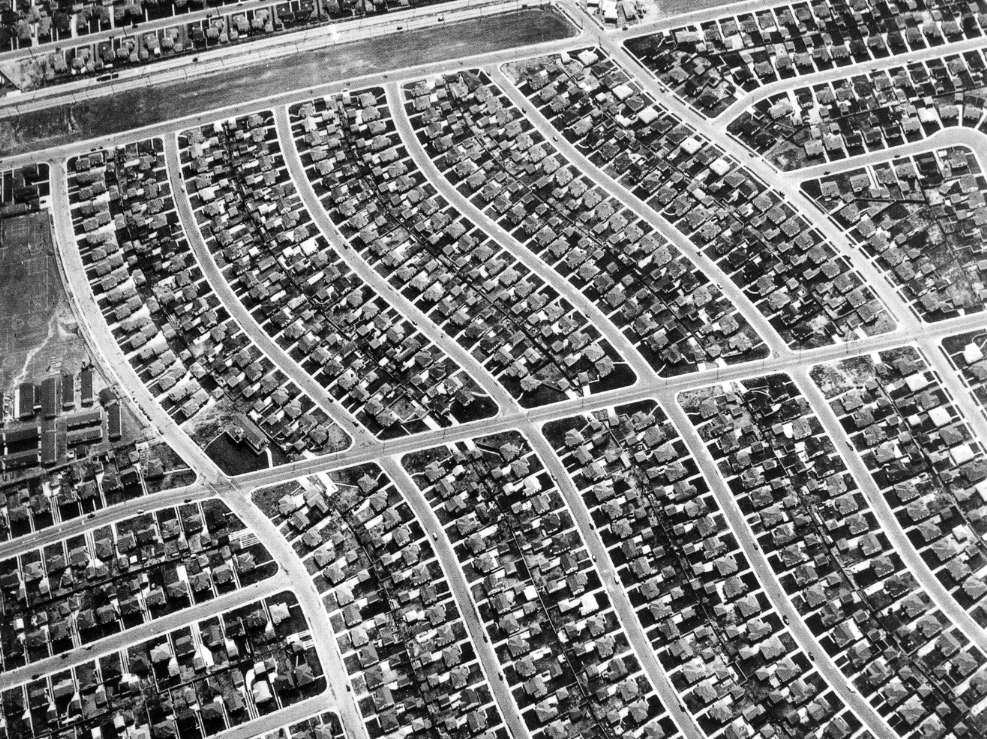
A post-war housing subdivision
outside Los Angeles
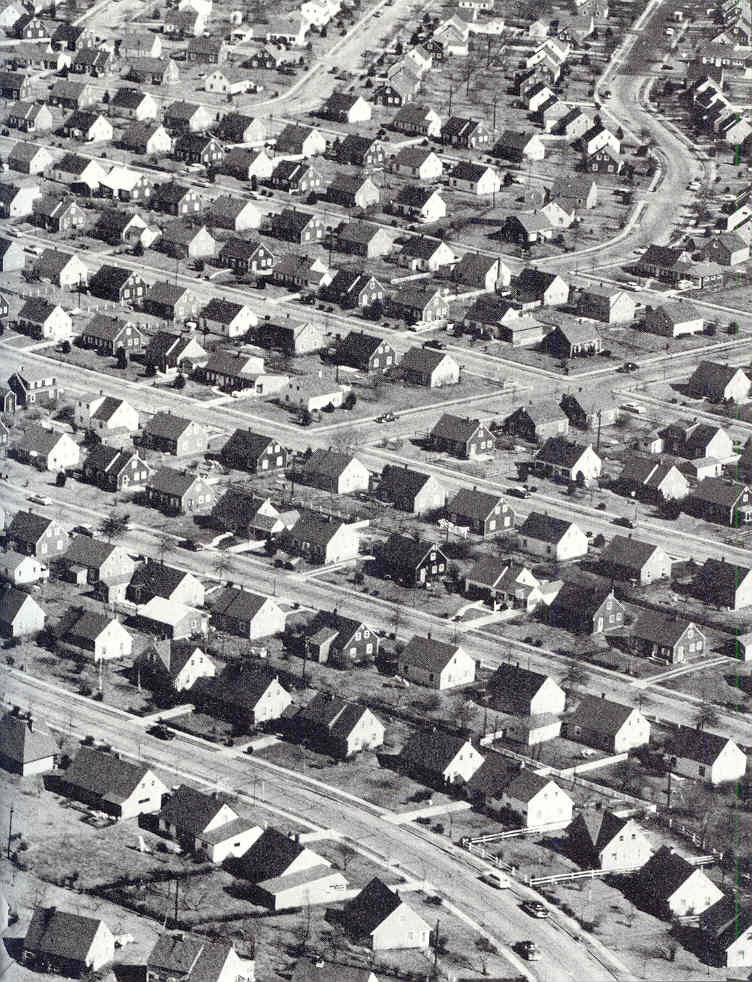
Levittown – Long Island -
home for more than 17,000 families – late 1940s
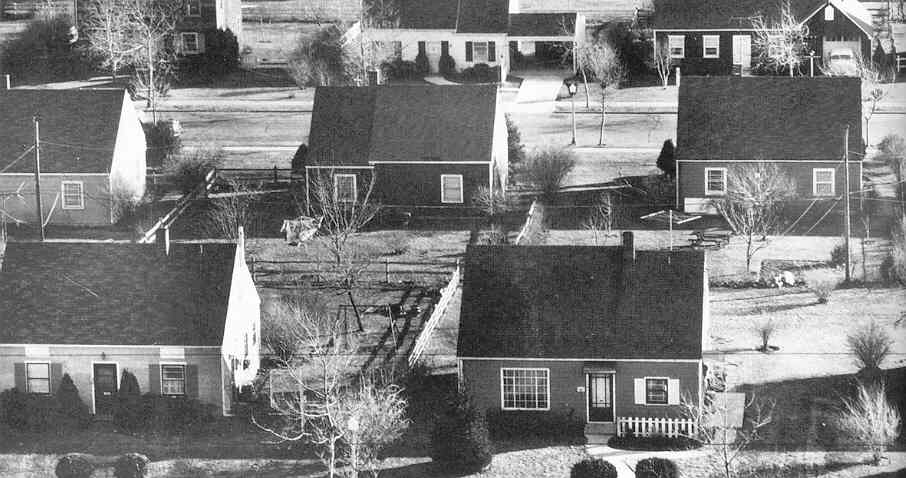
Rapid suburban housing growth
in the post-war years in America.
Housing starts jumped from 114,000 in
1944 to 1.7 million in 1950
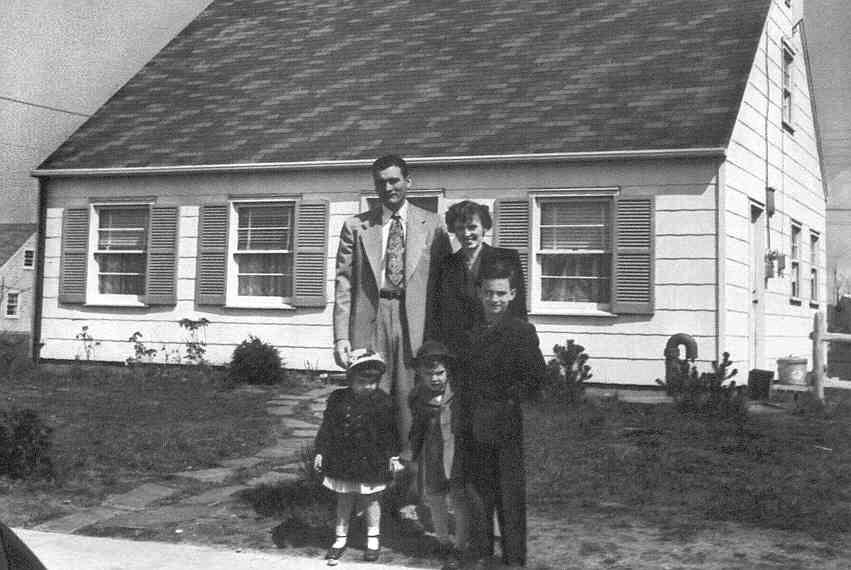
Suburban family in Levittown,
New York.
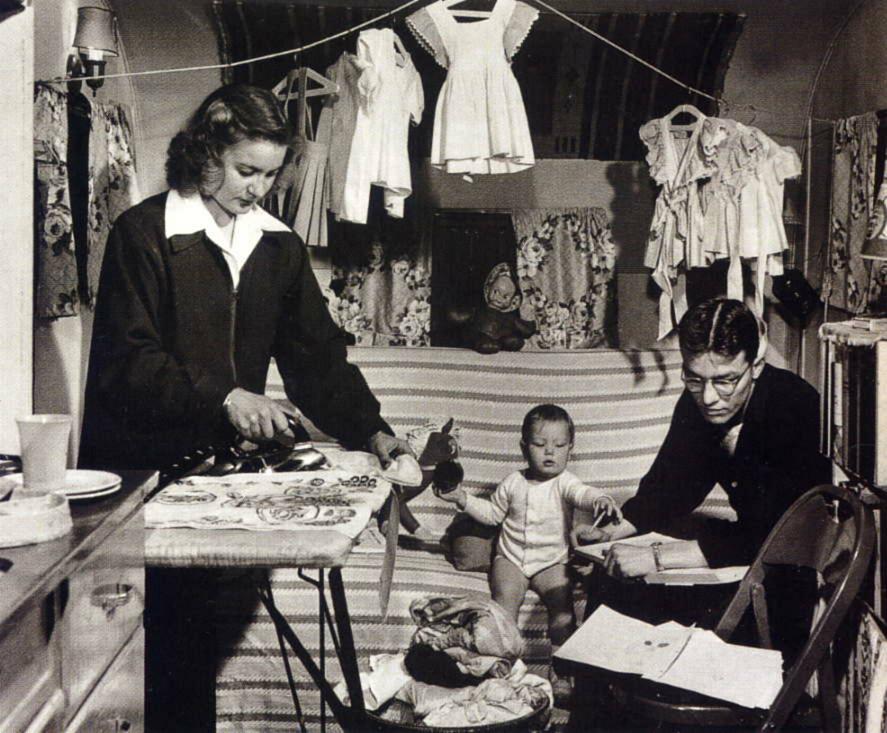
A young American post-war
family living on the GI Bill of Rights – 1947. Charles Smayda's wife irons while he studies
for his courses at the University of Iowa, his bills paid for by Uncle Sam.
In just the first 20 years of the GI Bill of Rights (1944-1964)
10 million
former servicemen were able
to attend college and 6.2 million able to buy their own homes.
The television has also brought a dramatic
change (enrichment?) to American life
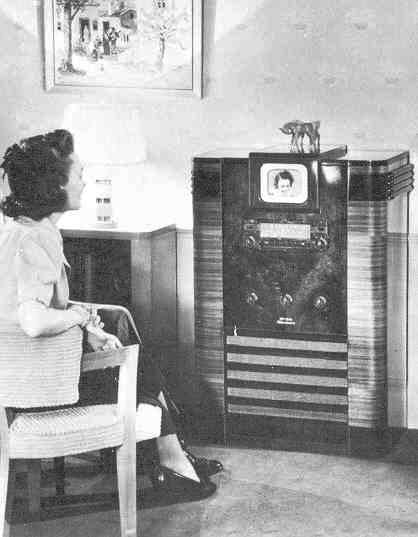 One of the very earliest
TVs
One of the very earliest
TVs
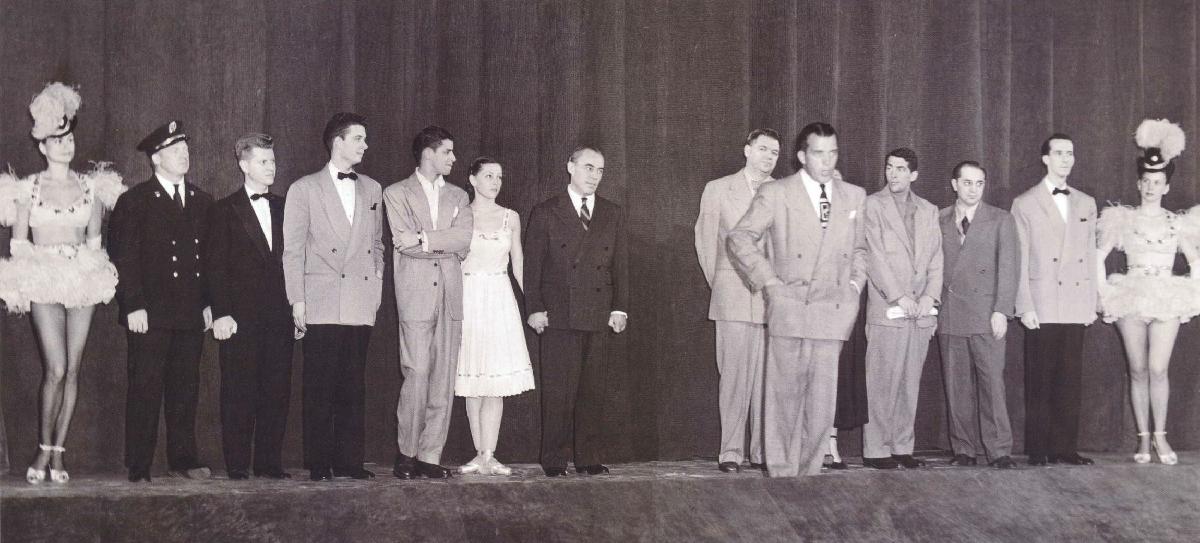
The opening night of the
CBS TV Ed Sullivan Show – 1948. Guests included Richard Rodgers and Oscar
Hammerstein, 22-year-old Jerry Lewis (3rd, 4th + 5th from
left) and Dean Martin (4th from right)
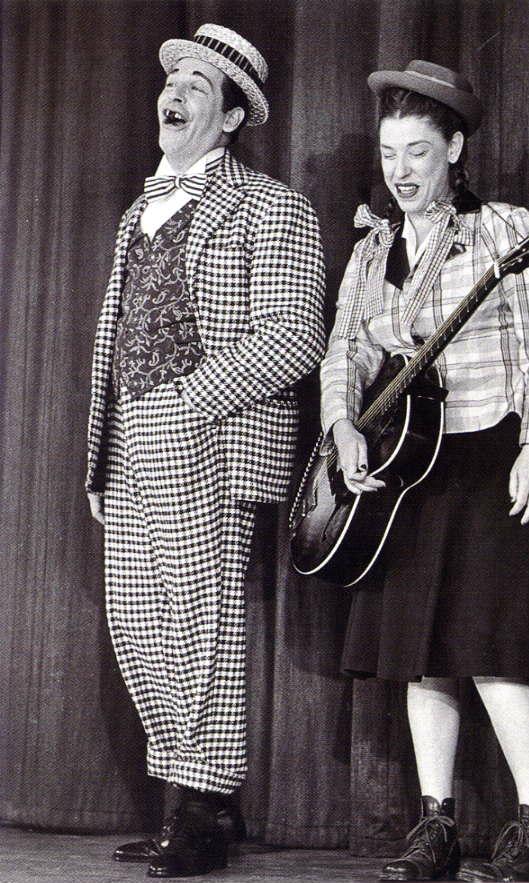
Milton Berle and Judy Canova – 1948
His Tuesday night NBC show mesmerized
the nation
CHRISTIANITY IN POST-WAR AMERICA |
|
Meanwhile, a combination of factors had developed
a quite obvious revival in America's attachment to its Christian
cultural roots. Most certainly, in this recent war with Germany and
Japan, Americans had faced the stress of war and all its accompanying
tragedies with much personal prayer for themselves as they faced the
grave dangers of battle, or for loved ones and friends who served
abroad. Roosevelt had prayed America through the war, and church
attendance had blossomed. America felt itself indeed to be very much a
Christian nation.
Christianity as strong personal faith
War, violence and death in battle call
forth a very different character in the people than the character
involved in simply supporting civic religion. Instead, typically, such
a deep challenge to human life brings forth in the personal lives of
individuals a very powerful Christian faith – again, one that is very
different from polite civic religion. Here is where personal faith that
stands at the heart of Christianity produces true human greatness,
human greatness such as God himself seeks in men and women. This is
when they put their life in the hands of God, not society.
Great leaders of the past understood this
key feature of Christianity. The Puritans built a strong Anglo society
in the wilderness of America through such faith. Washington and Lincoln
did not depend on social Christianity to support their actions, but
depended on strong personal faith in God to support them in taking on
huge risks – for themselves as well as the societies they led. This
faith guided, comforted and strengthened them through the most
uncertain and dangerous of times. They were leaders who built their
leadership on personal faith, not social approval.
And so it was the case in the 1940s for
multitudes of ordinary Americans – who put on uniforms and took up arms
to defeat two massive empires – putting behind, at enormous personal
risk, the safety and security of society in order to protect that very
safety and security of their society. In their own way, their personal
faith in a God who watched over them as they went to battle made them
into the same heroes as Washington and Lincoln, as had been the case
for American warriors in earlier days – and more than once. And these
World War Two Veterans (hereafter termed the "Vets" in this study) came
through that testing of themselves and their personal faiths with that
same strength of character, to now rebuild a world that had survived
the horrors of war. These Vets were thus Christians not found merely at
the Sunday-morning lineup in church (which sometimes they were not),
they were Christians of deep personal faith in God in Jesus Christ. And
together as a community, they formed the heart and soul of post-war
America.
Now again, coming out of this horrible
war with the Germans and Japanese, they found not rest and relaxation
but instead ongoing war, a new war – a Cold War. Challenging
circumstances produced by an aggressive Communism once again seemed to
have created a situation in which only God could adequately offer a
sense of true protection, diplomatic or military efforts seeming to
have little effect in stopping Communism’s advance abroad. The Cold War
with Soviet Russia – and its Godless Communist ideology – brought
forward the continuation of the very strong Christian character of the
American people, the same character that had just brought them through
their war with Germany and Japan. The Vets were exhausted from the
previous fight and they would gladly have avoided a second call to arms
if they could. But they understood the necessity of stepping forward
once again, to defend social virtue and faith values of critical
importance – to not only themselves personally, or to their precious
nation, but to the world itself, to the very survival of civilization
on this planet.
Christianity as civic religion
It was times like these that made
Christianity more than just a very socially-useful civic religion, that
is, the source of a moral code requiring proper language and behavior
designed to produce the "good society." There was nothing particularly
wrong with such an approach to Christianity. The Social Gospel was an
excellent moral underpinning for the Age of Progressivism. But again,
one did not need exactly to be a Christian to understand the importance
of excellent social behavior to make an equally excellent society.
Truman's own Christian faith
For Christian Americans, it was truly
miraculous that God put in their midst a man who was one of them, a
battle-tested soldier, someone who had tried and failed and then tried
again to move himself forward in life the "American way," who was a man
of great moral integrity in the way he handled power – and yet who
frequently used profanity and enjoyed playing poker and drinking
whiskey (major no-noes to certain Christians), just like one of the
boys!
Truman was not looking for social
approval – or at least not expecting it. He found that in his wife and
family – and he found it in God. He was a man of deep personal
faith.
A loyal Baptist, Truman as president
however was not regular in his Sunday worship, explaining the matter as
a result of finding himself in a job that kept him at work seven days a
week, morning, noon and night. Also, Truman was not at all like his
presidential successor Eisenhower, who understood the importance of
frequently just getting away from those same pressures, golfing or just
relaxing at a retreat (Eisenhower suffered a heart attack anyway).
Truman was something of a workaholic!
But he had a hugely uncharted course to
lead the nation on. And the European crises that exploded in the early
post-war years moved so fast that it seemed at times that only Truman
had the ability to respond to them quickly and effectively. His wisdom
in shaping an America ready to take on a new form of Cold War was
enormous. And he rested that wisdom on a very prayerful, deeply
scripturally- based Christian faith.
But he also understood the importance of
connecting the Christian faith with the American self-understanding of
the nation’s place in history. Several times he called for a National
Day of Prayer, specifically urging the nation to call on God to help
the people know what to do in the face of various challenges, even
crises, facing the nation. He also spoke openly before the American
public about how the Christian faith had formed the democratic
foundations of America and how America enjoyed its obvious blessings
because of a special trust God had put in place with the nation. And
Truman looked to the church (not Washington) to take the lead in the
battle against greed, racism, and injustice, both at home and abroad.
And perhaps most importantly for a
national leader whose most important task was to put a clear social
vision in front of the people he was destined to lead, Truman had a
very strong personal belief that America was called to show the world
how to live God's way, according to the very teachings of Scripture,
and the example of Christ: in charity and concern for others, even for
one's former enemy (in this case Germany and Japan). He truly believed
that if the world would simply live by Jesus's Sermon on the Mount
(Matthew chapters 7, 8 and 9) peace would prevail across the world.
This did not mean that the strongly
opinionated Truman did not find himself in opposition to aspects of the
way the Christian life was lived in America. More sophisticated
Christians, for instance, attacked him for his biblical simplicity,
seeing only foolish ignorance in Truman's hope that living according to
Biblical principles would bring the world a better peace. He also had a
terrible split with his long-time Baptist pastor Edward Pruden, when
Truman appointed General Mark Clark as his personal representative to
the Vatican. While this pleased America’s twenty-five million Catholics
immensely, it upset greatly many Protestant conservatives who were
deeply suspicious of any Catholic pro-Vatican "popery."
Christian corporate-America continues to
develop
Meanwhile, Vereide's Christian Leadership prayer-breakfast
groups not only continued their development through the war, in the
post-war period they expanded their reach not only across America but
across the world. Besides key corporate leaders, Washington senators
and congressmen filled the ranks of these prayer-breakfast groups as a
sense of moral-spiritual mission took center place in American
social-political thinking in the post-war period.
And then there was the very young Billy
Graham, who would have a huge impact in how Christian America would
develop over the next generation or two. He had started out with an
amazing revival – or crusade as he called it – in 1949 in Los Angeles
which over an eight-week period had drawn over 350 thousand people. The
next year he covered the country with his crusades, from Boston, to
Columbia (South Carolina), to Portland, to Atlanta, to other points in
between. By the next year the Graham name was well-known across the
country, and his crusades were so fully attended that often masses of
people had to be turned away when the stadiums had become completely
filled.
Unfortunately, Truman developed a
particular dislike for the evangelist Billy Graham, when in 1950 it
appeared to Truman that the young Graham had turned his visit to the
White House into a grand publicity opportunity for himself (actually
clumsily or even accidentally prompted by the press rather than Graham
himself).3
Nonetheless, Graham remained very popular
with Corporate America as well as Congressional America, though he
never succeeded in warming the heart of a suspicious Truman.
At the beginning of 1952 (mid-January to
mid-February) Graham found himself in Washington again, working closely
with Vereide in yet another major crusade, shaped clearly to help
Washington focus on key issues that needed the Christian touch. Indeed
about a third of the senators and a good number of congressmen attended
the crusade, along with another half million people (and millions more
listening in over the radio). So well was the crusade received that
Congress even at one point authorized it to move to the very steps of
the Capitol Building itself.
The Vereide-Graham impact
That same February, Congress took up the
idea of an annual National Day of Prayer, proposed as a Congressional
Act to which Truman, who generally did not like public displays of
religiosity, finally gave his approval. And thus began the annual
National Day of Prayer – eventually scheduled for the first Thursday in
May.
That same year Vereide was able to get
Congress on board with a National Prayer Breakfast, held in February of
1953, and which has been held annually in Washington on the first
Thursday of February ever since.
3Things
did not improve over the next couple of years when Graham complained
openly about Truman’s handling of the Korean War, the national debt,
political corruption in Washington, and Communist infiltration in
American society.
Despite – or because of – his success, America is challenged to define itself spiritually and morally
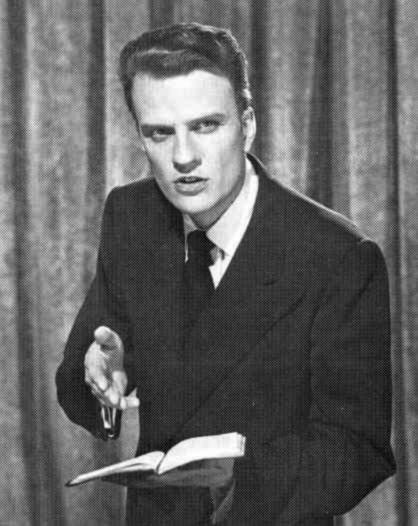
Christian Evangelist Billy
Graham
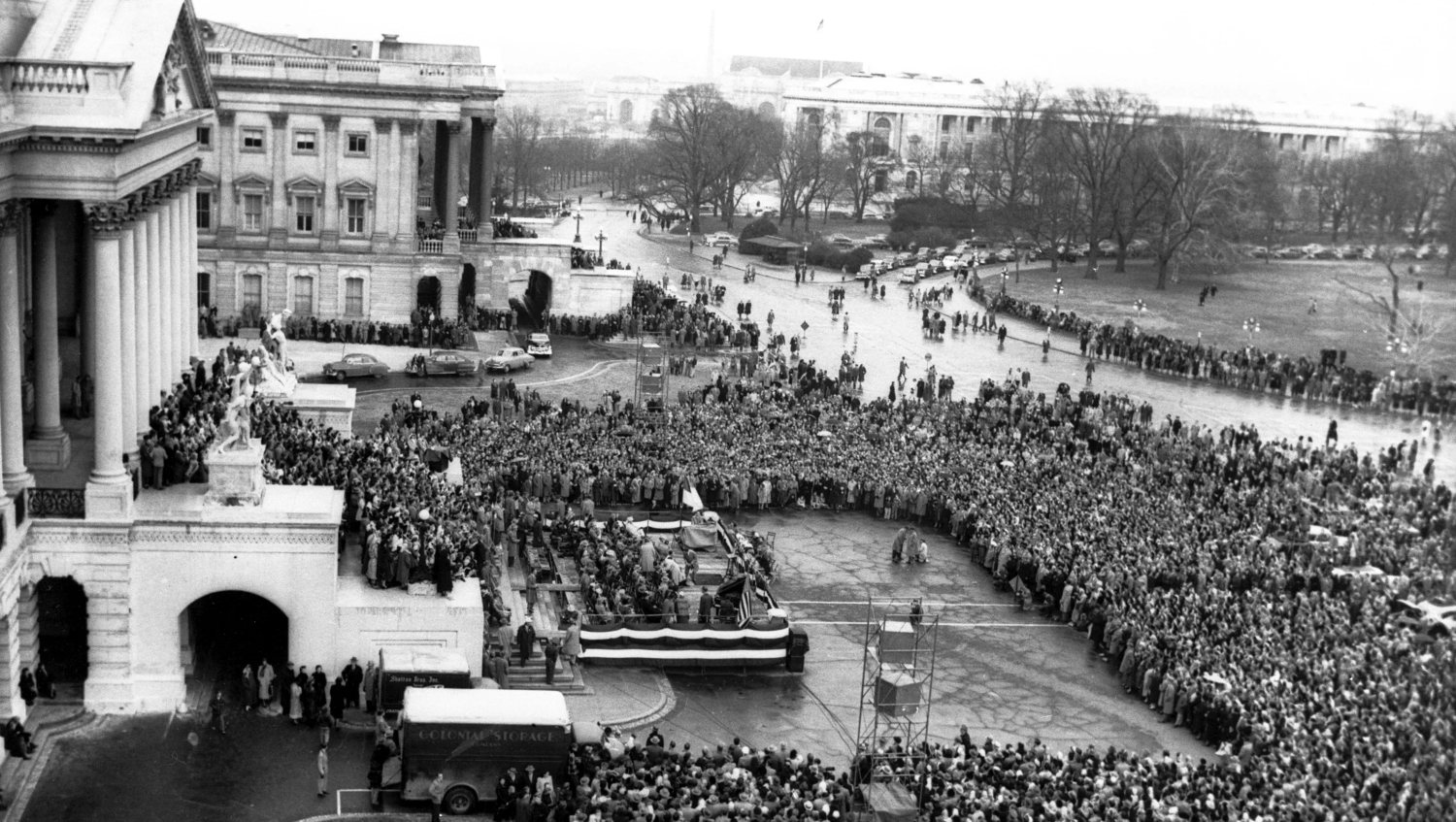
Even in the rain ... Graham could bring people out to his Crusade. Washington, D.C. – February 3, 1952
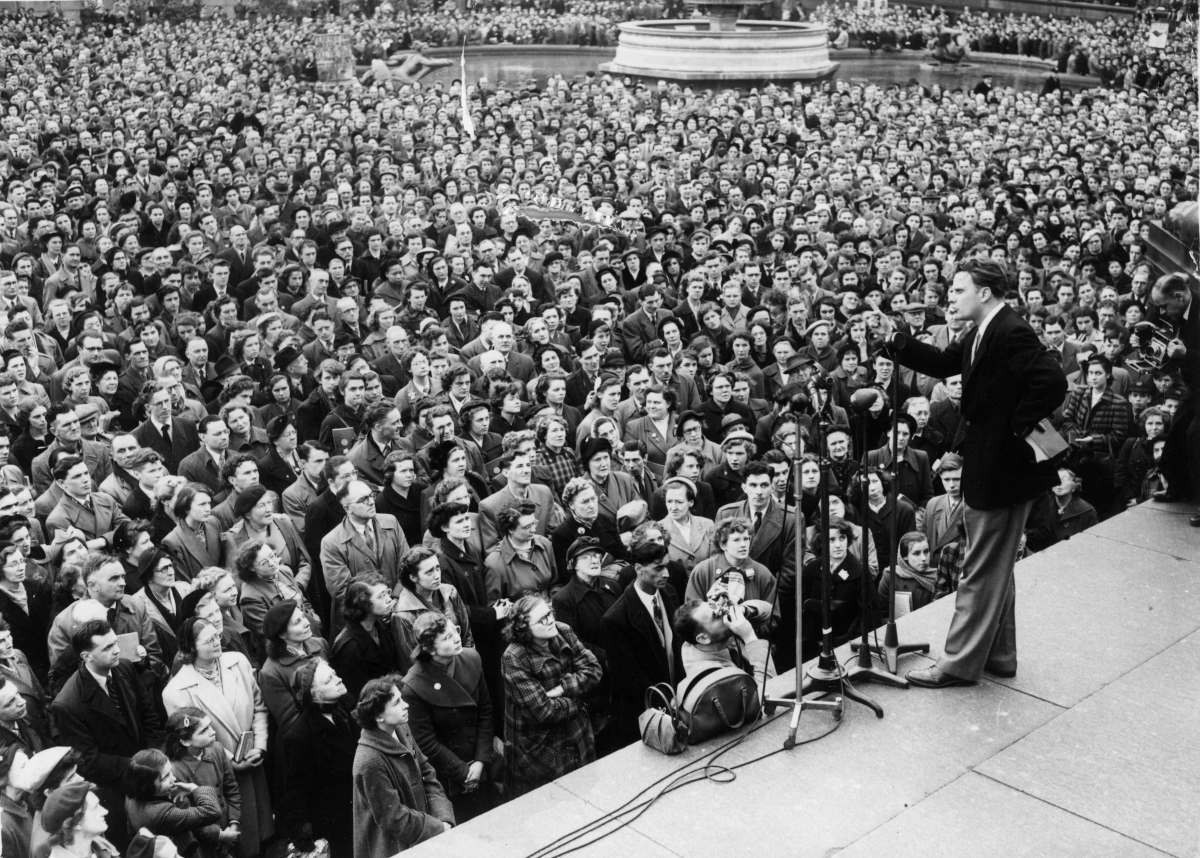
He could even bring out multitudes in London – April 5, 1954
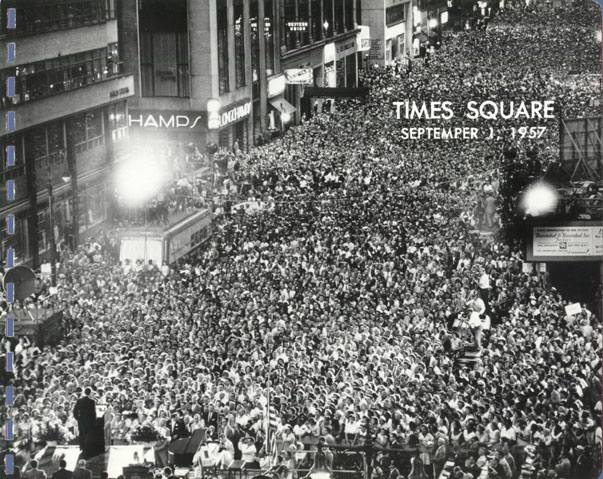
This picture speaks for itself!
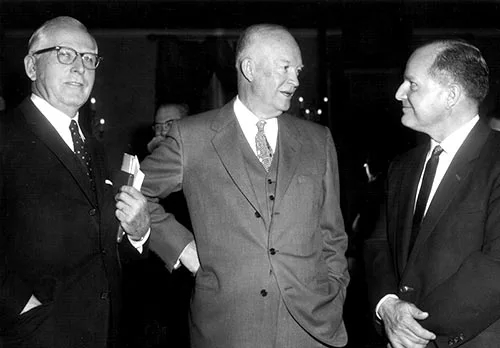
Vereide (left) and Eisenhower at the 1953 National Prayer Breakfast
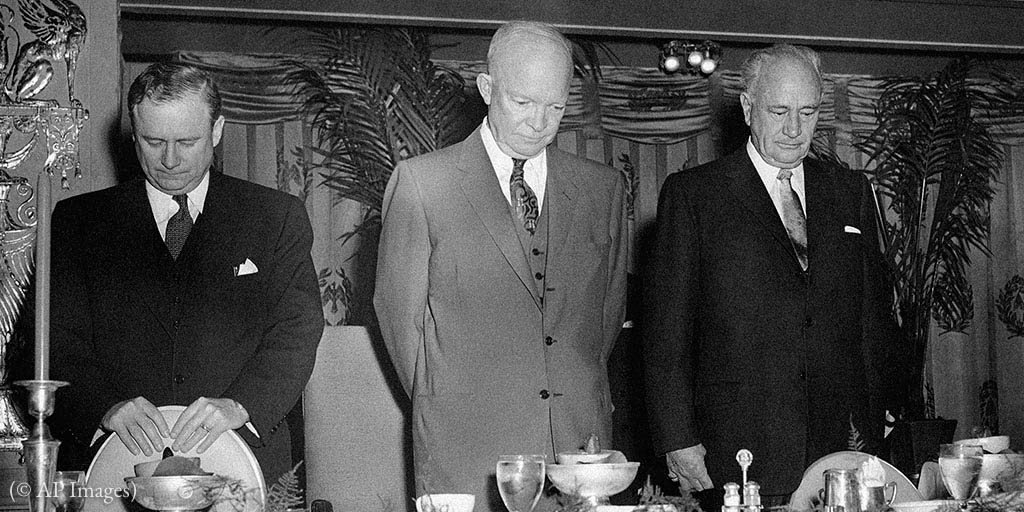
Eisenhower leading the 1956 National Prayer Breakfast
At the same time, America faces some deep moral challenges
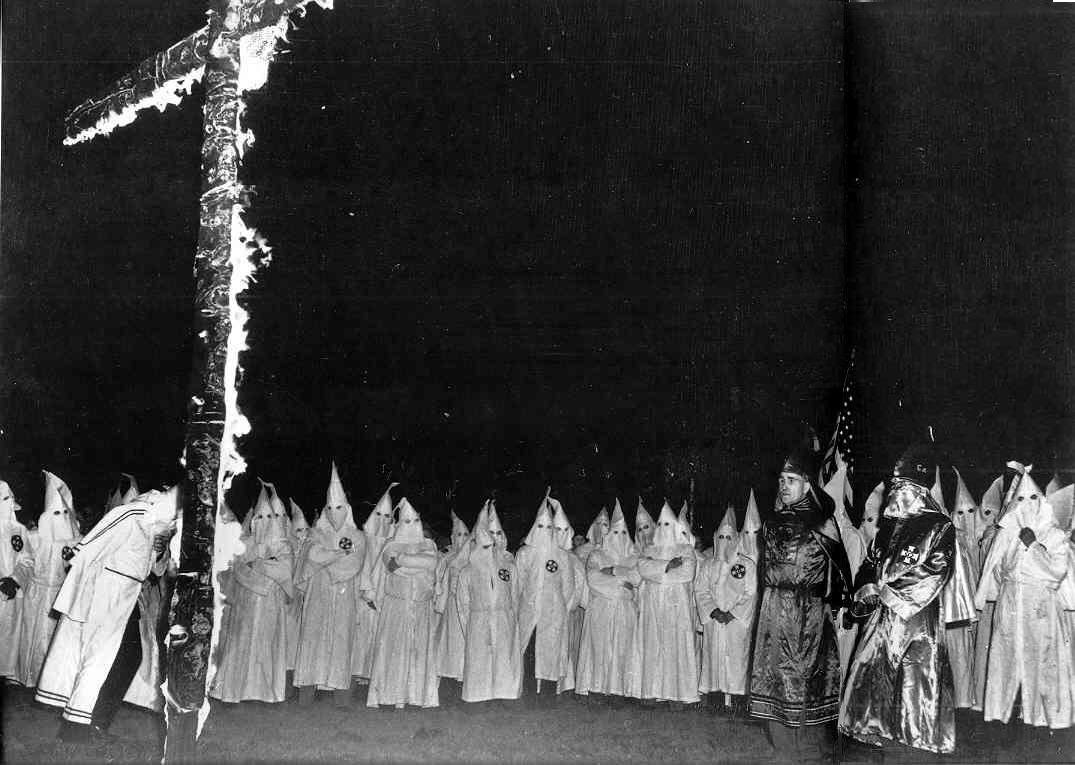
KKK gathering before the
county courthouse in Wrightsville, Georgia – March 2, 1948
And American Labor is still suspicious of the holders of American wealth

Tough labor leader, John
L. Lewis, receiving the stare of a rich lady
U.S. ELECTIONS – 1948
DOES
AMERICA STAND WITH TRUMAN – OR ARE THEY READY FOR A CHANGE? |
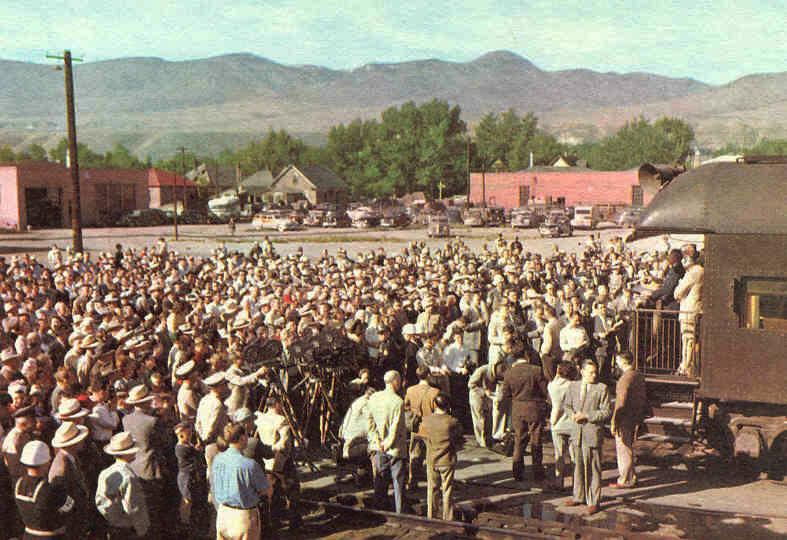
Truman in Idaho tirelessly
engaged in whistle-stop stumping – 1948
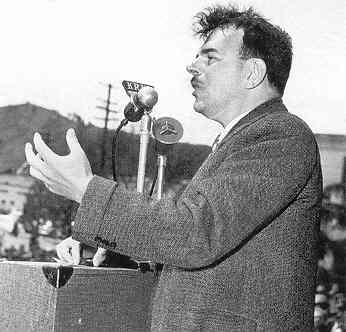 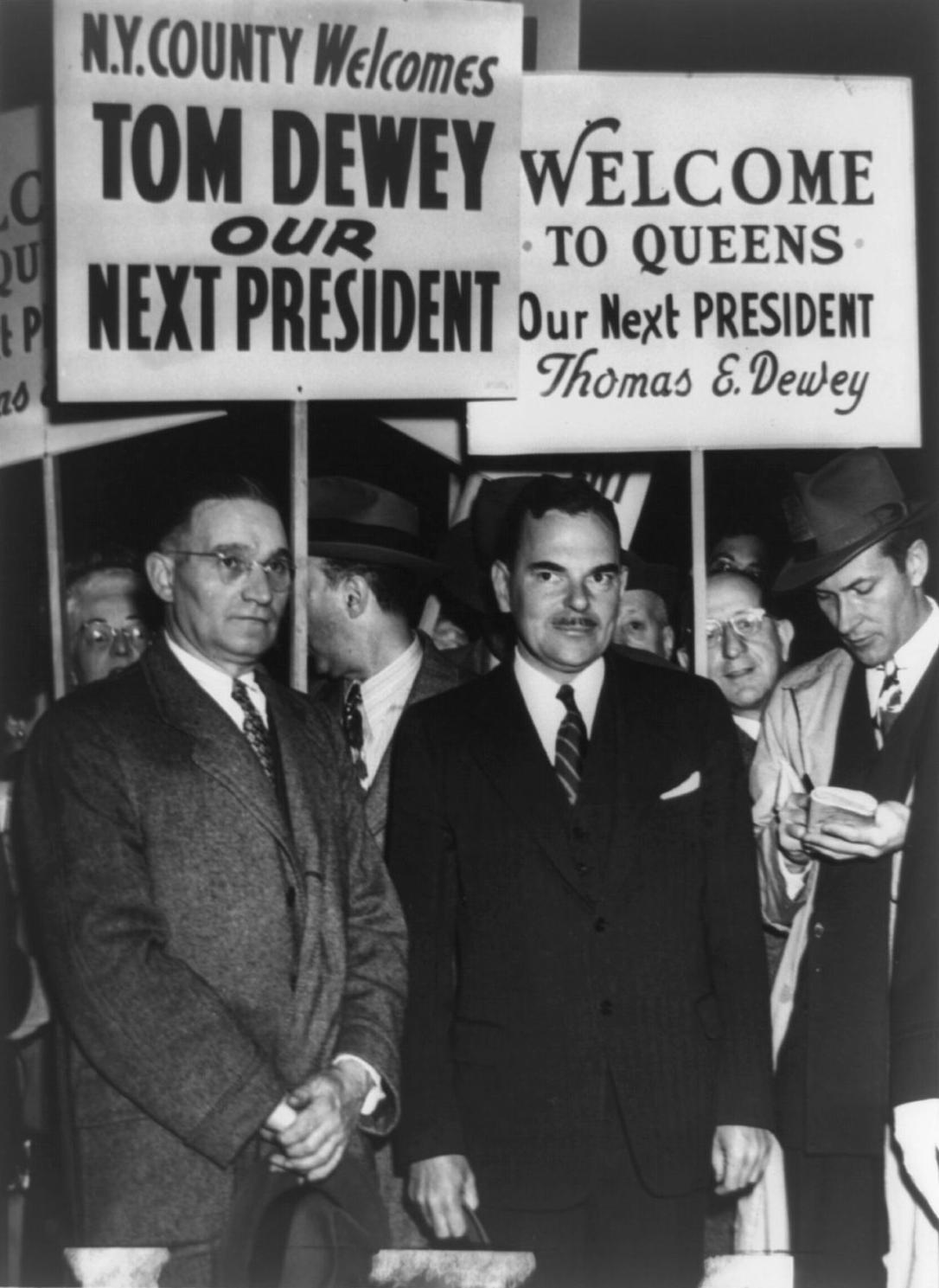
Republican Presidential Candidate
Thomas Dewey campaigning – 1948
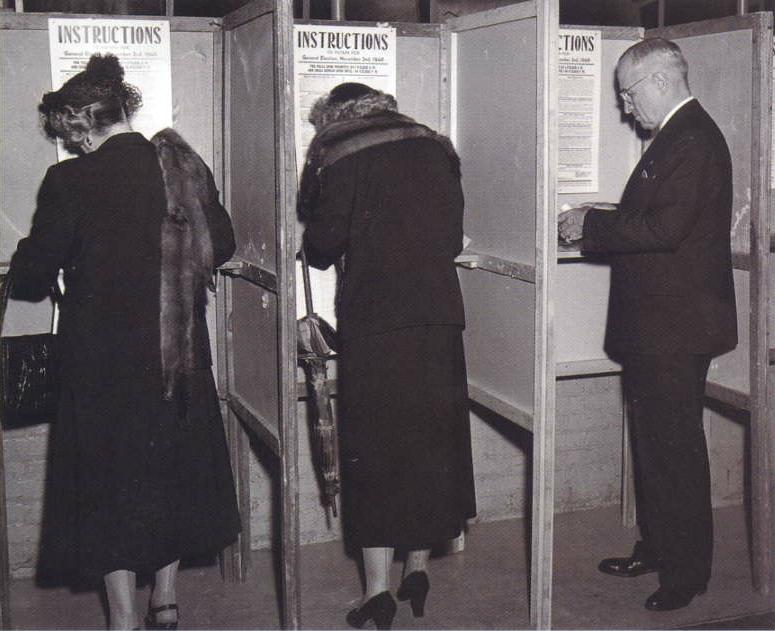
President Harry Truman, his
daughter Margaret, and his wife Bess voting in the national elections
in Independence, Missouri – 1948
All the polls indicated that Harry
would suffer a big loss in the election to Dewey. Wrong!
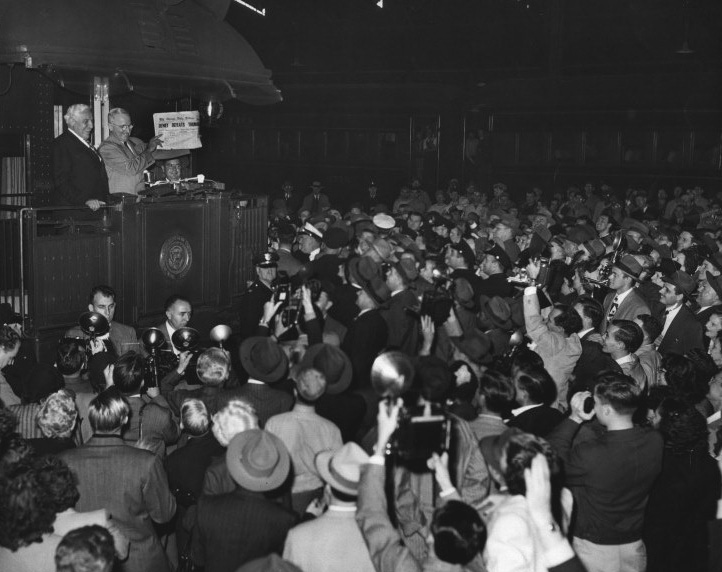 President Truman holds up
the Chicago Daily Tribune headline, "Dewey Defeats Truman" in
St. Louis, Missouri – November 3, 1948.
President Truman holds up
the Chicago Daily Tribune headline, "Dewey Defeats Truman" in
St. Louis, Missouri – November 3, 1948.
The Harry S. Truman Library
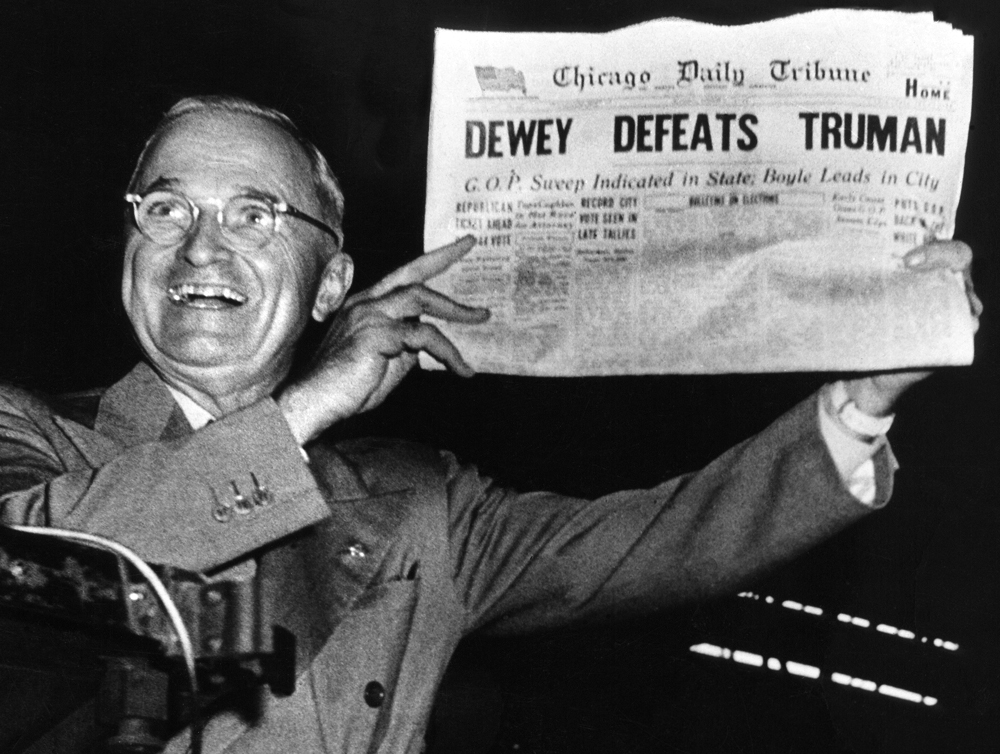
Truman displays headlines
from the Chicago Daily Tribune prematurely announcing his defeat - November 1948
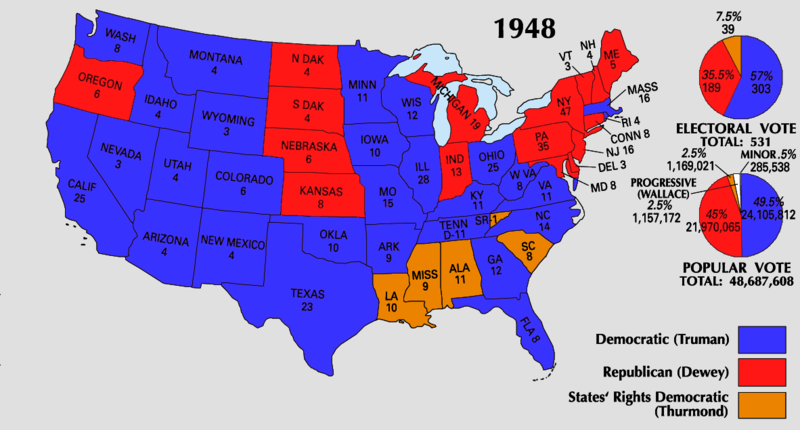
A COLD WAR DEVELOPS AT HOME IN AMERICA |
|
But even in all of this Christian faith there
lurked the constant fear of totalitarian evil – clearly now in the form
of Soviet Communism – overcoming America and the world. Indeed this
fear fed the readiness of Americans to turn ever more critically to
their Christian faith for comfort and counsel. Having to go to battle
against the totalitarian regimes of Germany and Japan – only then to
see the Soviet Russian totalitarian system wanting to take their place
of dominance in the world – troubled the American heart deeply. Brutal
totalitarianism seemed to be a growing danger built somewhat inevitably
into the modern world, and its ever-developing technology.
In 1949, a book written by English
author, George Orwell, became an American huge best-seller – a book
describing the horrors of rising authoritarianism. It was a novel
describing the oppressed existence of the hero, who was living in a
time when everyone, everything, fairly widely across the entire world,
lived in response to the omnipresent will of Big Brother. Through the
discipline of The Party, Big Brother controlled the entire thought
process and behavior of everyone in Oceanic society – so much so that
there was virtually no way to escape The Party's program of social
mind-control. The novel projected this kind of authoritarianism or even
totalitarianism as a distinct future possibility: as far off, but also
as near, as the year 1984.
Of course Americans were already well
aware that something like such Orwellian totalitarianism had already
been set loose in their world. Americans had fought the Germans and
Japanese, who seemed to have come completely under such mind control so
as to be able to do the terrible things that they were able to do in
Europe and Asia. Then there was the dawning realization that Uncle Joe
Stalin operated in much the same manner in Russia – in fact maybe ever
more horrifyingly so. In short, the world had recently entered an era
in which social organization and social technology made such a
frightening life possible, anywhere – possibly even in America ...
should certain horrible social developments take place in that country
as well. After all, it had happened to Germany and Japan. It had
happened to Russia. It could possibly also happen to America. Americans
were thus very nervous about this matter – even greatly frightened.
Questions of disloyalty in high places Thus as the post-war 1940s progressed, concerns began to grow
ever-stronger about such creeping totalitarianism. In particular,
concern was great that some of America's own citizens had been (and
possibly still were) dangerously supportive of America's former ally,
Communist – and thus by Communism's very definition, totalitarian –
Soviet Russia. The involvement of such pro-Soviet individuals,
especially in high-level security matters, had compromised greatly
America's national security – and possibly was still doing so.
Pressures were mounting on and within Congress to probe this matter, to
see how big of a problem this might actually be, this question of
national loyalty – or even outright espionage.
The House Un-American Activities Committee (HUAC)
Looking into this matter was Congress's
House Un-American Activities Committee, better known simply as HUAC.
This Congressional committee had actually been created back in 1938
over a concern about the spread of Communism into the ranks of the
American citizenry – especially among the American intellectuals, who
seemed particularly fascinated with Marxism, and into the American
labor movement, whose anti-capitalist rhetoric seemed to put them in
the same category. Then during the war, HUAC members went after the
Japanese-American community on the West coast, fearing that they might
be fifth-columnists for the Japanese imperial army. Following the war,
attention then turned back again to the question of the extent of
Communism within certain American social circles (again, principally
intellectuals and labor unions).
Then in 1947 HUAC’s attention turned to
Hollywood, because of what were considered Leftist messages coming
through the movie industry, especially by way of a number of
screenwriters whose material was considered Communist in inspiration.
Soon the spotlight focused on ten out of the many accused of advancing
Communist propaganda, who were blacklisted and thus untouchable by any
Hollywood company for employment. But over time that number extended to
over 300 individuals to be named and thus boycotted by the movie
industry. Even famous actors (Orson Welles, Paul Robeson, Charlie
Chaplin) were brought under scrutiny, to the extent that they finally
decided to simply leave the country or operate under a pseudonym.
In fact, by 1949 Hollywood was beginning
to respond to the Red Scare by coming out with a number of its own
strongly anti-Communist movies, thus directing the gaze of HUAC away
from their studios.
Communists within the upper reaches of American government service
In 1948 the nation was shocked to hear
the accusations coming from HUAC that a top level employee of the U.S.
Treasury Department, Harry Dexter White (the senior American official
at the 1944 Bretton Woods Conference), and Alger Hiss, one of
Roosevelt's top State Department officials (who was with him at the
Yalta discussions shaping the post-war world), and a number of other
individuals, were active Communists – assisting the Soviets by passing
on to them top secret information. White answered his accusers by dying
of a heart attack only a few days after the accusation was made public.
Hiss however held firm in denying the charges, although another
individual, Whittaker Chambers, who openly admitted that he had been a
Communist spy, claimed (citing specific details) that he had been
passing on information that Hiss had given him.
American intellectuals protested that all
this seemed to be merely a Middle-Class "witch hunt" against their
social betters, motivated simply by the instinctive resentment by
commoners against their more talented members of society (the highly
educated White, for instance, was a product of Columbia, Stanford and
Harvard University educations, and Hiss was a Johns Hopkins University
and Harvard Law School graduate).
Resentment by American intellectuals was
aimed particularly at the freshman congressman and HUAC member Richard
Nixon, who refused to relent in his investigation of Hiss, which
eventually led to the conviction and imprisonment of this polished
diplomat – to the dismay (and eternal resentment) of his fellow
intellectuals.4 The
intellectual community would thus never forgive Nixon … ever. To them
he would always be "Tricky Dick," nothing more than a rabble rouser
posing as an American patriot.
A growing suspicion about Soviet spying
on the part of America's nuclear scientists
On another front, many of the brightest
American scientists had been involved in Leftist organizations in their
university days. But at the time, that did not set off any particular
suspicions about loyalties – not until the Cold War started up anyway.
Many scientists were foreign-born escapees from the Hitlerian nightmare
in Europe. It was supposed at the time that their mutual interest in
bringing down Hitler would be their sole concern. But after the War
their personal interests and loyalties became much more complex (the
victorious allies had even brought Nazi scientists on board to continue
to advance their respective nuclear or military research programs as
the East-West Cold War competition intensified).
What role spying and trading inside
information to the Cold War adversary actually played in the overall
nuclear development is still not quite certain. Nonetheless,
revelations in the early 1950s of spying by scientists, whom Americans
all assumed possessed the highest integrity of all people, shook an
already very nervous country. Because of the intelligence work of the
Venona project (which had cracked the Soviet code and exposed some of
the spying going on within the West) Klaus Fuchs was confronted – and
in January of 1950 confessed his role as a spy. His statements
implicated Harry Gold, which in turn led to David Greenglass and
ultimately to Julius and Ethel Rosenberg – individuals deeply involved
in the development of America's nuclear weaponry. All of these
individuals came under suspicion of having passed on nuclear secrets to
the Soviets. There were others as well accused and ultimately convicted
of spying in the early 1950s, though only Julius and Ethel Rosenberg
were executed – despite the huge international call for clemency (they
claimed innocence to the end).5
This too had the effect of increasing the moral distance between Middle
America and its cultural and scientific intellectual class.
4Actually,
in the opening of the Russian archives after the collapse of the Soviet
Union in the early 1990s it was confirmed that indeed both White and
Hiss had been spying for Stalin.
5Again,
with the fall of the Soviet Union in the early 1990s, it was finally
revealed that indeed the Rosenbergs (or at least Julius Rosenberg) too
had been Soviet spies.
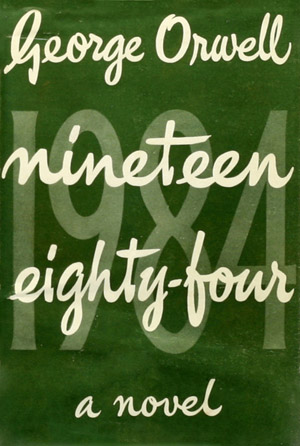 
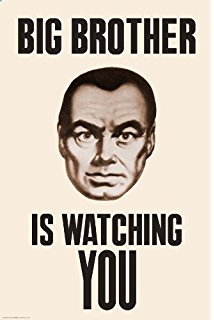 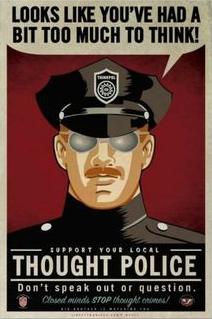
The sentiment is growing
that Communism is threatening to do in the American nation "from within." Special targets of American
concern are certain Hollywood
personalities
with "Leftist" philosophies – and even members of the U.S. State
Department 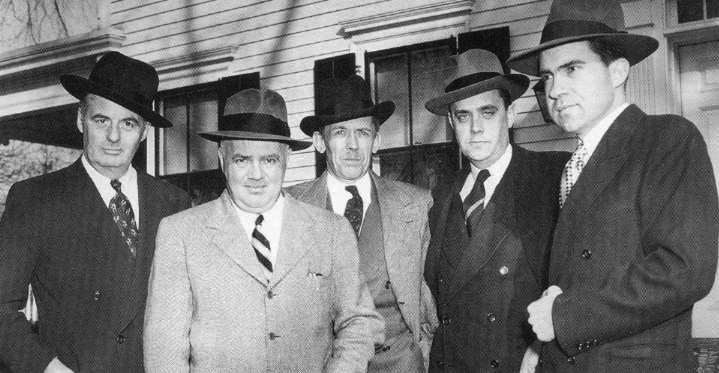
Republican members of the
House Un-American Activities Committee (HUAC) – 1948 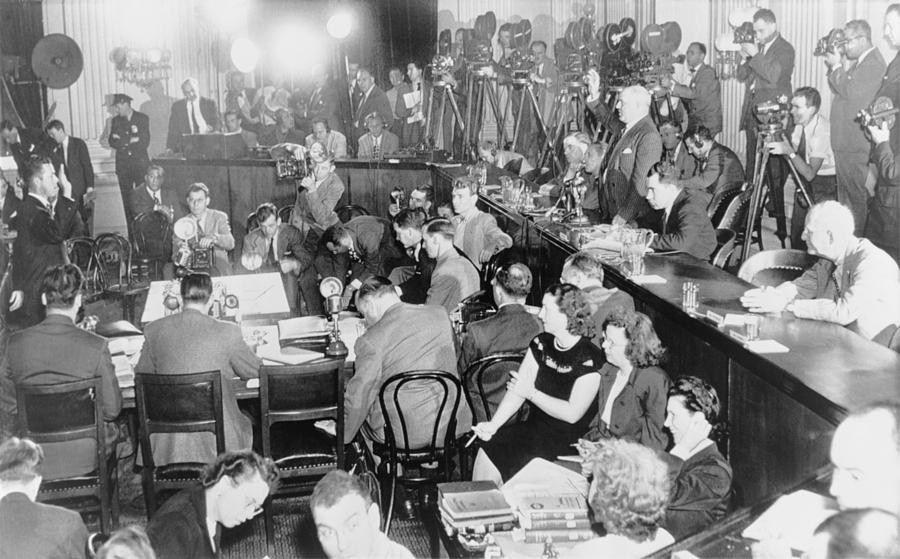
HUAC hearings of those accused of
having ... or having had ... Communist associations A startling accusation was that
Hollywood
was full of Reds
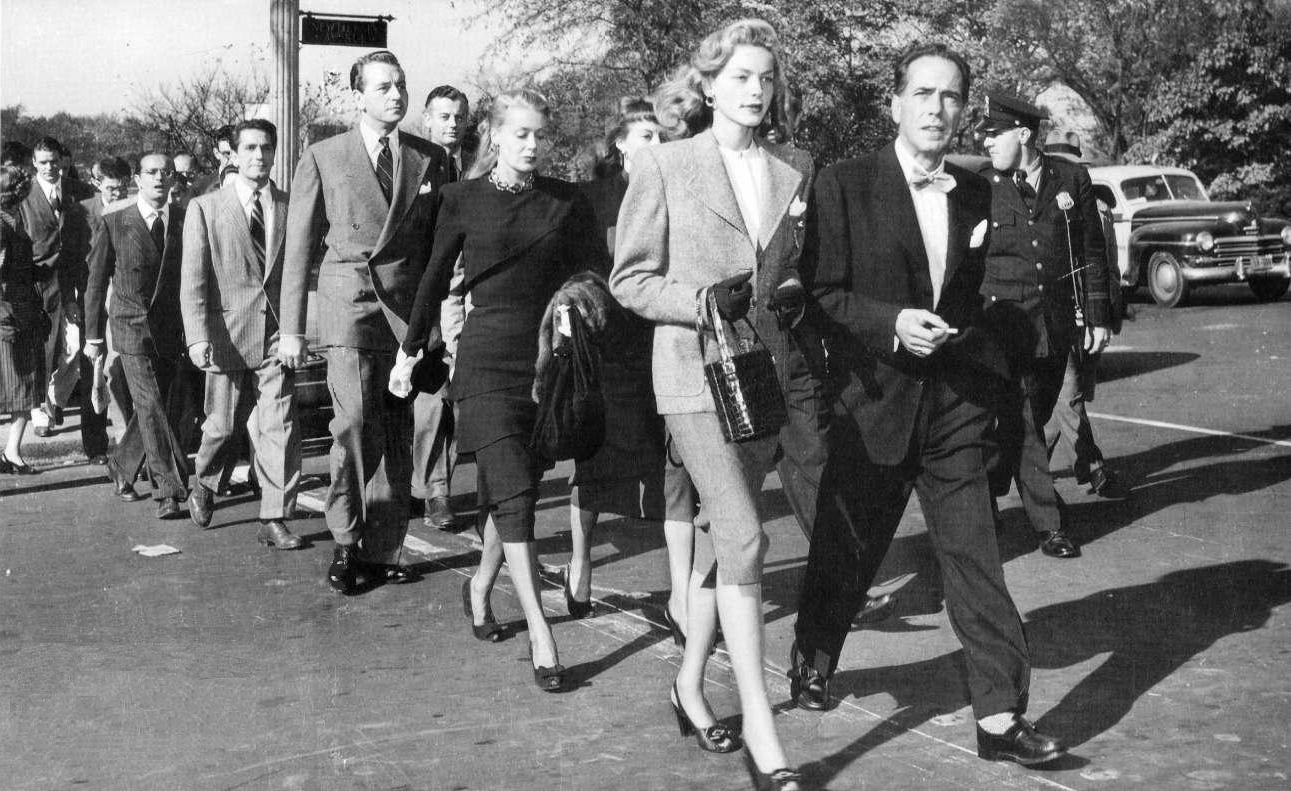
Hollywood stars (Lauren Bacall
and Humphrey Bogart in the lead) descend on the Capitol to
lodge their note of protest against HUAC's proceedings – 1947 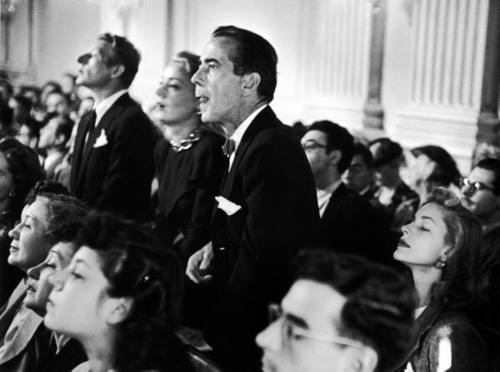 Danny Kaye, June Havoc, Humphrey
Bogart and Lauren Bacall at HUAC hearings – 1947 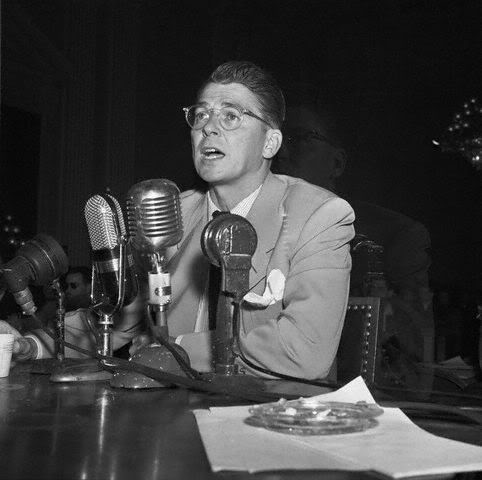 Screen Actors Guild president
Ronald Reagan testifying before HUAC – 1947 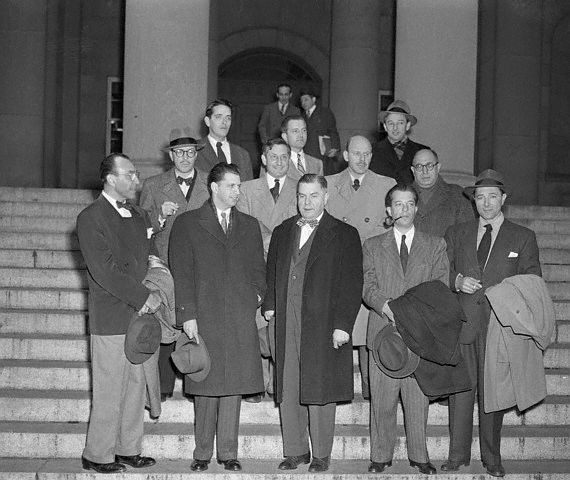
The Hollywood Ten (and their lawyers), the original
victims of the Hollywood blacklist
Back row: Ring Lardner Jr.,
Edward Dmytryk, Adrian Scott
Middle row: Dalton Trumbo,
John Howard Lawson, Alvah Bessie, Samuel Ornitz.
Front row: Herbert
Biberman, Martin Popper, Robert W. Kenny, Albert Maltz, Lester
Cole.
The accusation that the U.S.
State Department purposely "lost" China to the Communists
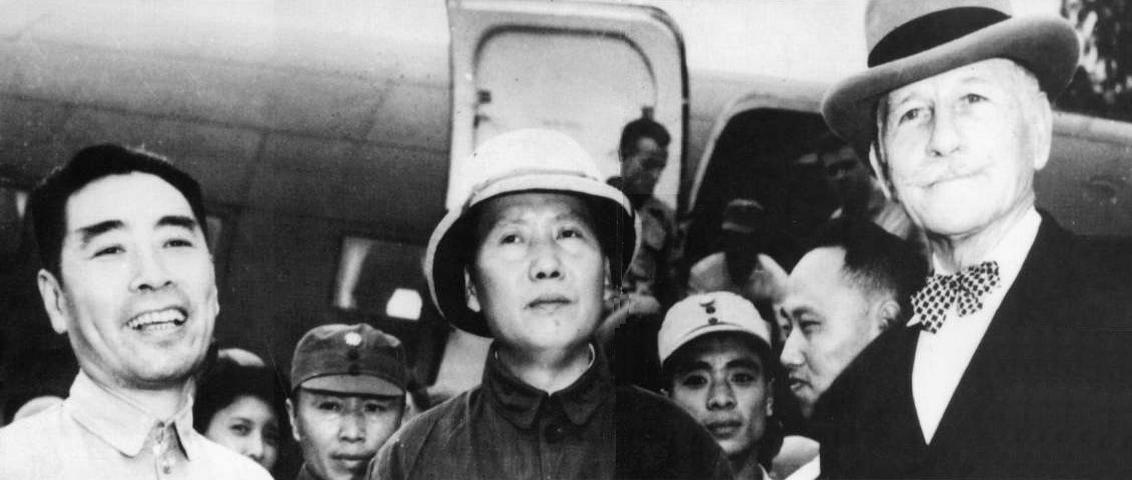
Patrick Hurley in China with
Communist leaders Zhou Enlai (left) and Mao Zedong (center) – 1945
National
Archives NA-208-PU-207W-2
| Hurley was commissioned to get the
Communist leaders together with the Nationalist leader Chiang Kai-shek
to form a Chinese post-war coalition government. But this effort
failed as Hurley threw his support to Chiang. The foreign service
officers working with him refused to go along with this. He later
accused the State Department of being pro-Communist and having "lost" China
to Communism. |
The idea of the State Department
having "lost China to Communism" was coupled with an accusation that the State
Department had also "sold out East Europe" to Stalin 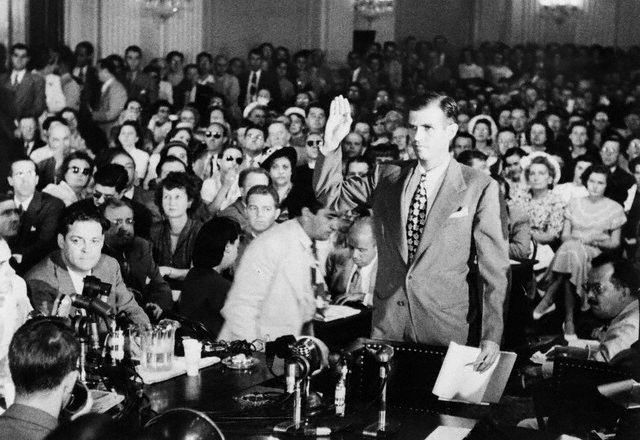 U.S. State Department official Alger
Hiss taking the oath before the HUAC
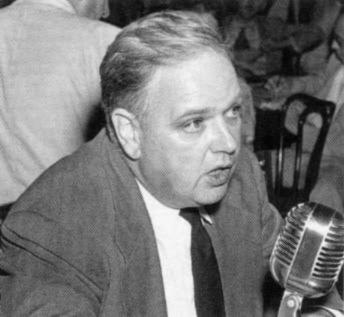 Whittaker Chambers accuses
Alger Hiss of passing information to the Soviets 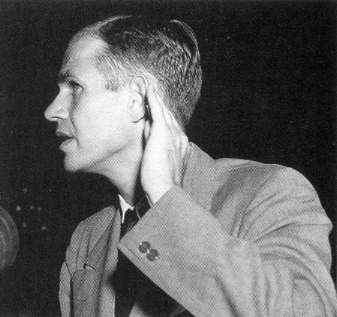
 
Richard Nixon (left), who
headed up the HUAC investigation of Alger Hiss (right)
as a Soviet agent planted
high within the American foreign policy-making machine
When the Soviets developed
their own atomic bomb – well in advance of what America had anticipated – the fear of nuclear attack puts the nation's nerves on constant edge
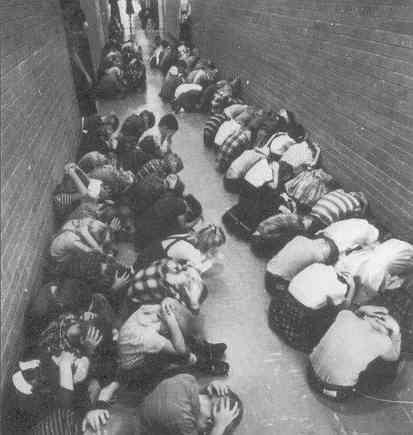 Air raid drill at
school
Air raid drill at
school
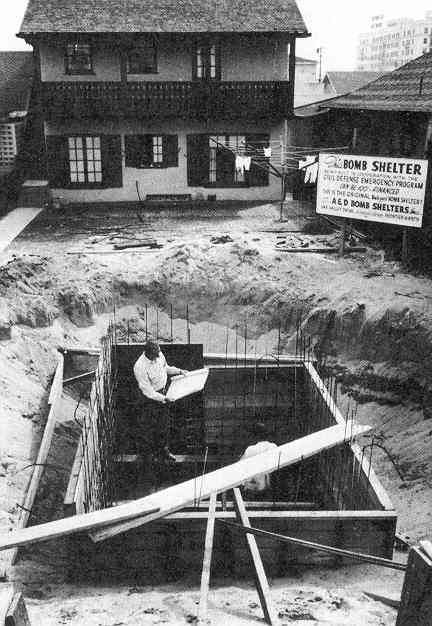
Building a backyard bomb
shelter in Hermosa Beach, California – 1951
The speed of Soviet nuclear development also aroused
American suspicions that the
Soviets might have received inside help from among our own nuclear scientists.
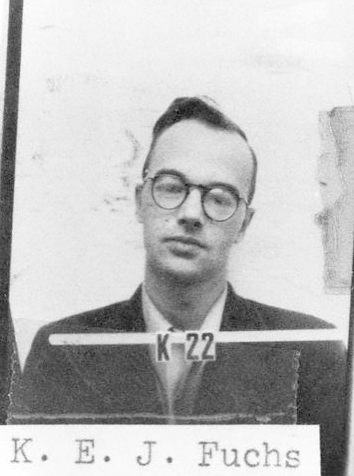 Klaus Fuchs' I.D. badge at
the Los Alamos National Laboratory
Klaus Fuchs' I.D. badge at
the Los Alamos National Laboratory
Los Alamos National
Laboratory
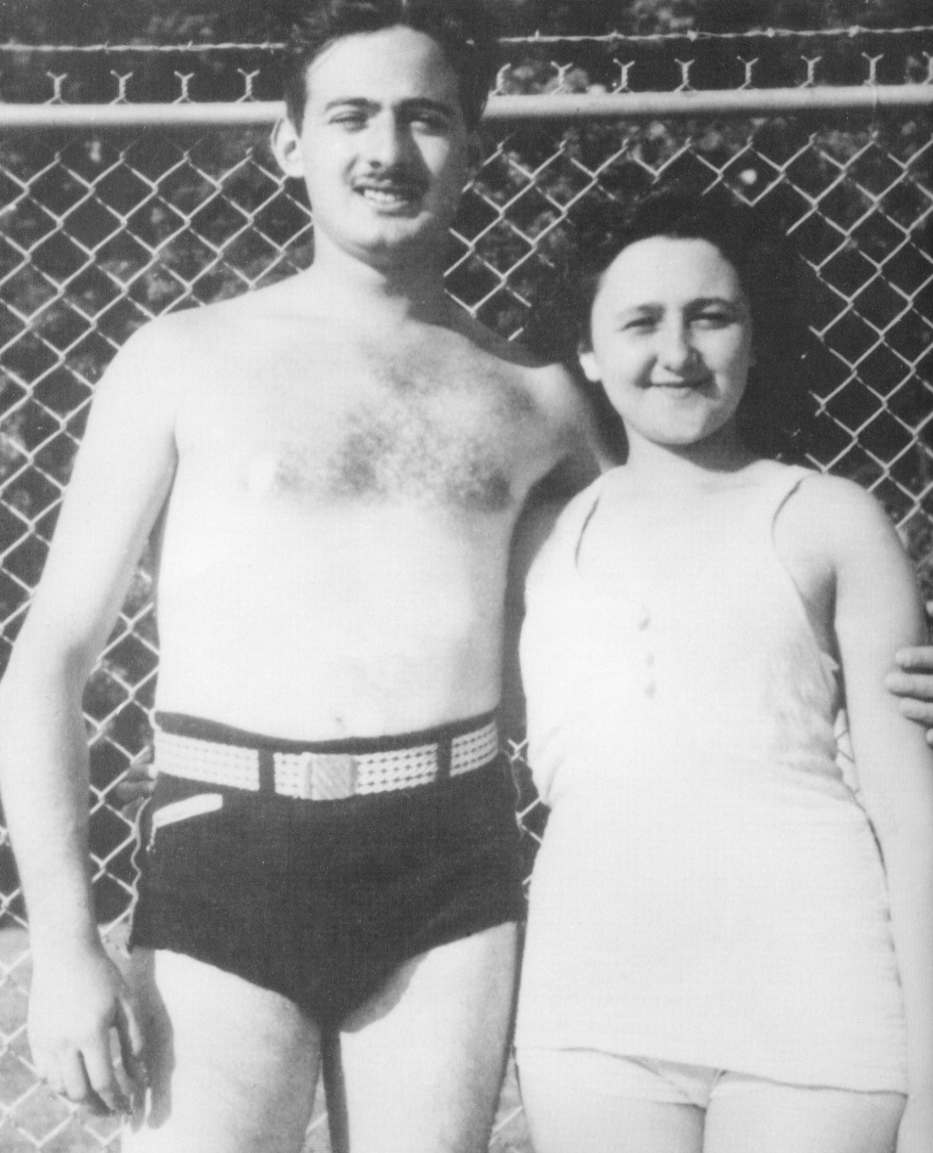
Julius and Ethel Rosenberg
at a happier moment in their lives – prior to their arrest and
trial for selling U.S. atomic bomb information to the Soviets in 1945
(they were found guilty
and electrocuted on June 19, 1953)
F.B.I.
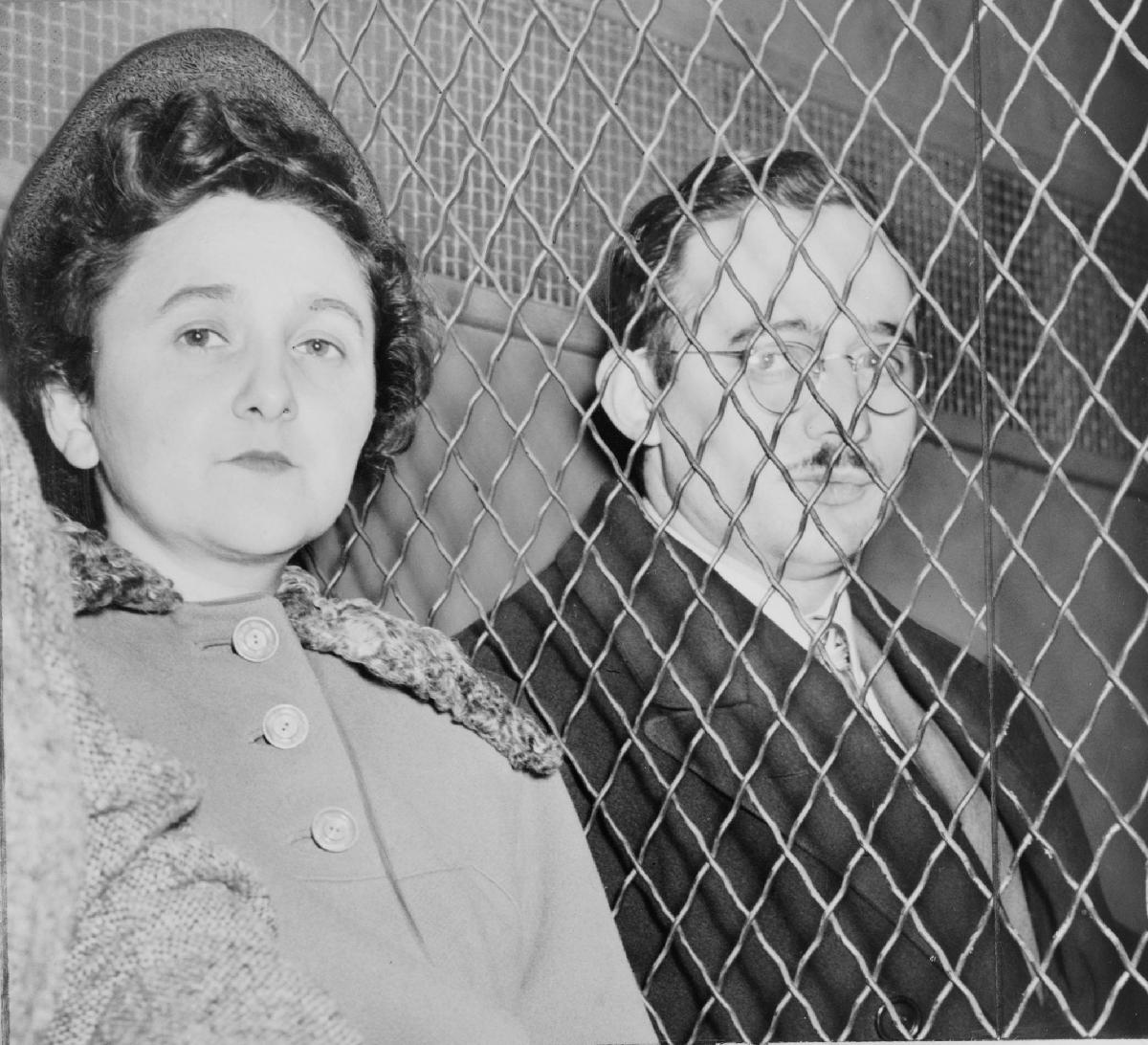
Julius and Ethel Rosenberg
after their conviction
THE SUPREME COURT TAKES ITS FIRST STEPS IN REFEREEING AMERICA'S RELIGIOUS LIFE |
|
As we have noted throughout this work, the
people's religion had always played a key role in the life of the
American nation since its founding centuries earlier. It certainly was
held quite strongly at the time of the drafting of the Constitution
back in 1787, as demonstrated in Ben Franklin's call to the
Constitutional Convention to begin each of its daily sessions praying
for Divine guidance in its proceedings.
Jefferson, however, was someone in those
days who would have preferred that such public religion played no such
role in the life of the young Republic. His moral-spiritual preferences
lay with properly-developed Human Reason. And in his later years he
would be a particularly strong advocate for this more "rational"
approach to life.
But he himself was not part of the group
that wrote the Constitution, being off in France as the Republic's
representative to the French government at the time. But he would
finally – years after his death – have a huge impact finally on how
America was to come eventually to view the place of America's
traditional Christianity in the life of the nation.
This would occur through a seemingly
innocent event in 1947, one that would not at the time draw much
notice. But this event was the start of a development that would have
huge implications as to how American culture was to move forward over
the next several generations. What is being referenced here is the
famous (famous later, anyway) Everson v. Board of Education court case.
This key Supreme Court case would
introduce into American culture the idea that somehow the American
Constitution establishes a "wall of separation between church and
state." This case would have huge implications in terms of how America
would thus soon be reading the protections written into the First
Amendment. It would open the doors to the Orwellian fear that
thought-control from on high might eventually take over the country,
that even in America there might someday develop a public authority
with no known limits to its power, able to alter, redirect and even
undo the long-held features of the nation's most precious moral and
spiritual character. ndeed, on the basis of the Supreme Court's
re-reading of the First Amendment, the Supreme Court would bring itself
gradually, step by step, to take the position that – like Orwell's Big
Brother – it had the right to dictate what religious views could and
could not be brought into the ever-widening "public" realm, one
increasingly directed by Washington authorities themselves.
This all began when the Supreme Court issued its 5-4 decision in the Everson v. Board of Education case, ruling against the
New Jersey plaintiff who claimed that public support for the bussing of
students to religious (Catholic) schools was in violation of the U.S.
Constitution. According to the Supreme Court decision, New Jersey
school authorities in fact had every right to give full support to its
tax-paying public, even if it meant paying for public transportation to
private Catholic schools. Thus the decision at the time caused no
particular stir. It seemed to be quite strongly in support of religion
in America's public life.
However, what was not realized at the
time was the critical impact this decision would have on the way future
Supreme Court decisions would go forward against Christianity practiced
in public life – citing this particular court case as providing the
precedent for such Court decisions.
That is because the explanation given at
the time for this particular Court decision was that the bussing
reimbursement was distributed to parents without regard to the
religious affiliation of the parents, and thus did not violate "the
wall of separation between church and state" implicit in the First
Amendment to the Constitution. What "wall of separation"? The
Constitution mentions no "wall of separation." The Constitution’s First
Amendment itself states simply but quite clearly:
Congress
shall make no law respecting an establishment of religion, or
prohibiting the free exercise thereof; or abridging the freedom of
speech, or of the press; or the right of the people peaceably to
assemble, and to petition the Government for a redress of grievances.
The Amendment makes it clear that the Federal Government is
to stay out of the business of religion, as well as speech, the press,
etc. Those matters belong to the people themselves, not the government,
neither to require nor to prohibit.
The First Amendment begins its list of
precious rights or freedoms of the people with the matter of religion
because this was the one area that so much controversy had developed
over back in the 1700s. The freedom of religion was a very big deal in
colonial America.
The term itself, "wall of separation,"
actually came from a letter written by Thomas Jefferson (at that point
the U.S. president) in 1801 (some fourteen years after the Constitution
was actually written) to the Danbury (Connecticut) Baptist Association.
In this letter Jefferson describes such a "wall of separation."
Indeed, Jefferson in his younger years
had fought the place of political privilege in Virginia enjoyed by the
Church of England, because of its royal sponsorship under the
Hanoverian kings, who were of course the head of that very institution.
Something similar to that same place of privilege had been enjoyed by
the Congregational Churches in New England, and the New England
Baptists also had been long opposed to that privilege … often bitterly
so. Thus Jefferson and the Baptists were in agreement that no religious
group should enjoy such preferential treatment by the governing public
authorities.
In general, this idea that no particular
religion should enjoy special privileges actually was shared widely
across America at the time that Jefferson wrote the letter – as was
also the case in post-World-War-Two America. Of course to post-war
America, this did not mean that there was to be no religion.
It was just that there was to be no particular religion enforced by the
powers of the state. That was the people’s – and only the people’s –
jurisdiction. Thus supposedly the wall of separation was an acceptable
concept … as long as it was understood to mean a wall keeping the state
out of the business of the people’s religion. The First Amendment
certainly did not mean – as the Supreme Court would, beginning in the
early 1960s, turn the Amendment to mean – that religion was to be
excluded or walled off from America’s public life. Hardly so, for
Americans held their Christian religion as a key part of their national
identity, especially in the Godless age of Fascism and Communism. But
in any case, that was a matter of the people alone to decide and
support, not the Federal Government. That seemed clear enough at the
time. And thus the Supreme Court’s decision raised no alarm bells back
in 1947.
But they were not yet understanding the
implications of this 1947 court decision. It raised all kinds of
questions which would then have to be eventually answered, again by the
Supreme Court as it took on these matters as falling completely within
its jurisdiction. Would the Supreme Court also claim the same thing for
speech and the press, that a wall of separation existed there as well,
and that the people’s thoughts and words were to be walled off from the
federal state’s official thoughts and words? This was what was
happening in totalitarian societies all around the world – where the
government suppressed all public thoughts, all social commentaries, all
beliefs that did not conform to the official version of thoughts and
beliefs, usually some quite atheistic, supposedly more scientific,
theory of society ... one that left all power in the hands of an
enlightened political elite.
In any case, with the 1947 Everson v. Board of Education
decision, the Supreme Court opened the door for future court decisions
to do just that – by judicial decree, move to establish Secularism (so
beloved by the Humanists) as the only worldview to be allowed and
supported by America's public authorities, because Secularism was
supposed to be "non-religion" (oh, really?!!) and thus not forbidden in
public life.
Not immediately, but gradually over the
next quarter of a century, the authority of the state (as per several
decisions of the Supreme Court) would reach vigorously into America's
public schooling and its curriculum, and ultimately permit only the
Secularist worldview to be taught to America's future generations.
But the very strongly Christian Vets did
not see this coming. Thus little was said at the time (1947) about this
Jeffersonian idea of a wall of separation, because Vets went at life
with the understanding that America was a nation under God. There was
no such wall prohibiting religion in their world. Who would dare to
think it could be otherwise?
But big changes in this long-standing
view were soon to come to America and its freedom of religion, thanks
to the enlightened views of a handful of ideologically-inspired lawyers
in black robes.
|
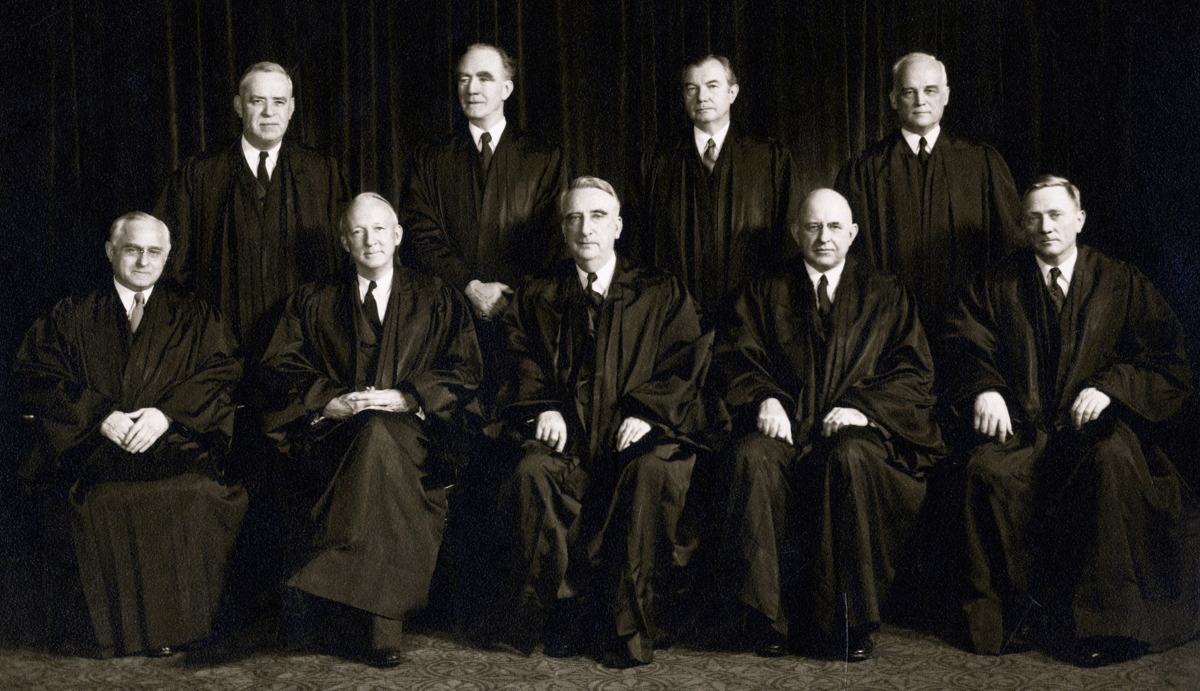
The Vinson Court that made the Everson ruling
Back row: Wiley Rutlege, Frank Murphy, Robert H, Jackson, Harold H. Burton
Front row: Felix Frankfurter, Hugo L. Black, Fred M. Vinson, Stanley F. Reed, William O. Douglas

Go on to the next section: The Korean War (1950-1953)
 Miles
H. Hodges Miles
H. Hodges
| | | |


 Post-war dynamics in America
Post-war dynamics in America
 Christianity in post-war America
Christianity in post-war America
 A Cold War develops at home in America
A Cold War develops at home in America
 The Supreme Court begins to referee
The Supreme Court begins to referee














































